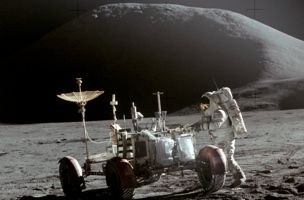NASA is asking vendors to submit LiDAR systems to help humans go as far as the red planet.
Last week, NASA published a request for information (RFI) for LiDAR systems. According to the RFI, “The LiDAR must be small, lightweight, low-power, and able to acquire 3D measurements (i.e., not just linear or planar ranging) to support short-range surface navigation (hazard-detection and localization).”
Why NASA will initially use the LiDAR system to localize and guide a lunar lander while it explores the surface of the Moon, with plans to take it all the way to Mars some day.
The requirements are strict, because the Moon is a slightly more challenging environment than your average construction site. It’s dusty, its temperatures are extreme, and its topography is tough to navigate. This is why NASA needs a LiDAR system that “shall be capable of detecting natural terrain hazards, such as rocks, craters, and slopes. The LiDAR system shall also be capable of supporting relative localization, such as 3D feature detection and tracking.”
Here’s a quick rundown of some of the actual specs that NASA is looking for, in case your company is thinking of pitching. NASA wants mass less than 5kg, power use less than 25 W, dimensions less than 15x15x25cm, frame rate greater than 1hz, field of view at least 45 deg. For reference, that’s only a little bit bigger than Velodyne’s Puck. Those specs won’t be easy to hit.
Why You Should Care
NASA needs the LiDAR for the RESOLVE project, which is a laborious acronym for “Regolith and Environment Science and Oxygen and Lunar Volatiles Extraction.”
The project is designing a Moon rover that can, according to statement from the agency, “drill into the lunar surface and heat the material collected so that we can measure the amount of water vapor and other compounds that are present, thus showing how future missions gather and then use these valuable resources.”
Designing a LiDAR system that enables a rover to find and melt water on the moon is important, because water can be processed into anything from air for astronauts to rocket fuel. If the technology works, we can use the Moon as a station on our way farther out into the solar system.
If the system works for mining resources on the Moon, NASA says, there’s no reason that it couldn’t be taken out to Mars, too. “Mars is a great example of why we need to use the resources at the destination,” said program lead Bill Larson. “Each human mission to Mars will last about 2.5 years. To reduce the amount of water and breathing air we have to send with astronauts, we will need to use the resources of the red planet to generate these life-essential commodities.”
Think of it this way: Design a better LiDAR system for NASA and you’ll play an integral part in putting humans on Mars. Again, if you’re interested, you can find the RFI here.






